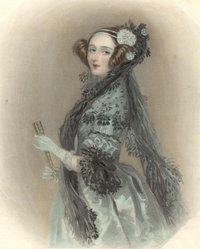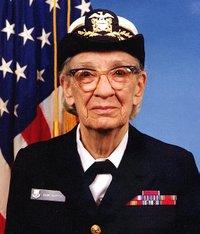Women and Computers
The Right Honourable Augusta Ada, Countess of Lovelace. (Ada Lovelace) - (December 10th 1815 - November 27th 1852)

During a nine-month period in 1842-1843, Ada translated for Babbage Italian mathematician Luigi Menabrea's memoir on Babbage's newest proposed machine, the Analytical Engine. With the article, she appended a set of Notes which specified in complete detail a method for calculating Bernoulli numbers with the Engine, recognized by historians as the world's first computer program. Biographers note, however, that the programs were written by Babbage himself, and Lovelace simply found a mistake in the program for calculating Bernoulli numbers and sent it back for amendment. The evidence and correspondence between Lovelace and Babbage indicate that he wrote all of the programs in the notes appended to the Menebrea translation. Her prose acknowledged some possibilities of the machine which Babbage never published, such as speculating that "the Engine might compose elaborate and scientific pieces of music of any degree of complexity or extent."
Ada Lovelace died at 36 after being bled to death by her physicians; she had uterine cancer. Thus, she died, ironically, not only at the same age as her father did, but even of the same cause - the mistaken custom of bloodletting. She left two sons and a daughter, Lady Anne Blunt, famous in her own right as a traveller in the Middle East and a breeder of Arabian horses.
At her own request, Lovelace was buried next to the father she never knew at the Church of St. Mary Magdalene in Hucknall, Nottingham. (http://en.wikipedia.org/wiki/Ada_Lovelace 20/10/05)
Trivia
• On December 10, 1980, (Ada's birthday), the U.S. Defense Department approved the reference manual for their new computer programming language, called "Ada".
• The U.S. Department of Defense Military Standard for Ada (MIL-STD-1815) was assigned a number to commemorate the year of her birth.
• On the math-mystery cartoon, Cyberchase, she appears as the animated character Lady Ada Lovelace, voiced by Saturday Night Live comedian Jane Curtin. The episode is "Hugs and Witches" (#201) which premiered February 14, 2002 on PBS Kids GO!.
• She is one of the main characters in the alternate history novel The Difference Engine by Bruce Sterling and William Gibson, which posits a world in which Babbage's machines were mass produced and the computer age started a century early.
• Lord Byron's Novel by John Crowley is a pastiche of a novel supposedly by Byron (in real life he did begin writing one, but is not known to have completed it), discovered after his death by his daughter, edited and with commentary by her.
• Her image can be seen on the Microsoft product authenticity hologram stickers.
(http://en.wikipedia.org/wiki/Ada_Lovelace 20/10/05)
Grace Hopper
(December 9th 1906 - January 1st 1992)

Throughout much of her later career, Grace Hopper was much in demand as a speaker at various computer-related events. She was well-known for her lively and irreverent speaking style, as well as a rich treasury of early "war stories".
While she was working on a Mark II computer at Harvard University, her associates discovered a moth stuck in a relay and thereby impeding operation, whereupon she remarked that they were "debugging" the system. Though the term computer bug cannot be definitively attributed to Admiral Hopper, she did bring the term into popularity. The remains of the moth can be found in the group's log book at the Naval Surface Warfare Center in Dahlgren, VA (NSWCDD).
Grace Hopper is famous for her nanoseconds visual aid. People (such as generals and admirals) used to ask her why satellite communication took so long. She started handing out pieces of wire which were under one foot long, which is the distance that light travels in one nanosecond. Later she used the same pieces of wire to illustrate why computers had to be small to be fast. At many of her talks, she handed out nanoseconds to everyone in the audience, contrasting them with a coil of wire nearly a thousand feet long, representing a microsecond.
(http://en.wikipedia.org/wiki/Grace_Hopper 20/10/05)
http://en.wikipedia.org/wiki/Women_in_computing

During a nine-month period in 1842-1843, Ada translated for Babbage Italian mathematician Luigi Menabrea's memoir on Babbage's newest proposed machine, the Analytical Engine. With the article, she appended a set of Notes which specified in complete detail a method for calculating Bernoulli numbers with the Engine, recognized by historians as the world's first computer program. Biographers note, however, that the programs were written by Babbage himself, and Lovelace simply found a mistake in the program for calculating Bernoulli numbers and sent it back for amendment. The evidence and correspondence between Lovelace and Babbage indicate that he wrote all of the programs in the notes appended to the Menebrea translation. Her prose acknowledged some possibilities of the machine which Babbage never published, such as speculating that "the Engine might compose elaborate and scientific pieces of music of any degree of complexity or extent."
Ada Lovelace died at 36 after being bled to death by her physicians; she had uterine cancer. Thus, she died, ironically, not only at the same age as her father did, but even of the same cause - the mistaken custom of bloodletting. She left two sons and a daughter, Lady Anne Blunt, famous in her own right as a traveller in the Middle East and a breeder of Arabian horses.
At her own request, Lovelace was buried next to the father she never knew at the Church of St. Mary Magdalene in Hucknall, Nottingham. (http://en.wikipedia.org/wiki/Ada_Lovelace 20/10/05)
Trivia
• On December 10, 1980, (Ada's birthday), the U.S. Defense Department approved the reference manual for their new computer programming language, called "Ada".
• The U.S. Department of Defense Military Standard for Ada (MIL-STD-1815) was assigned a number to commemorate the year of her birth.
• On the math-mystery cartoon, Cyberchase, she appears as the animated character Lady Ada Lovelace, voiced by Saturday Night Live comedian Jane Curtin. The episode is "Hugs and Witches" (#201) which premiered February 14, 2002 on PBS Kids GO!.
• She is one of the main characters in the alternate history novel The Difference Engine by Bruce Sterling and William Gibson, which posits a world in which Babbage's machines were mass produced and the computer age started a century early.
• Lord Byron's Novel by John Crowley is a pastiche of a novel supposedly by Byron (in real life he did begin writing one, but is not known to have completed it), discovered after his death by his daughter, edited and with commentary by her.
• Her image can be seen on the Microsoft product authenticity hologram stickers.
(http://en.wikipedia.org/wiki/Ada_Lovelace 20/10/05)
Grace Hopper
(December 9th 1906 - January 1st 1992)

Throughout much of her later career, Grace Hopper was much in demand as a speaker at various computer-related events. She was well-known for her lively and irreverent speaking style, as well as a rich treasury of early "war stories".
While she was working on a Mark II computer at Harvard University, her associates discovered a moth stuck in a relay and thereby impeding operation, whereupon she remarked that they were "debugging" the system. Though the term computer bug cannot be definitively attributed to Admiral Hopper, she did bring the term into popularity. The remains of the moth can be found in the group's log book at the Naval Surface Warfare Center in Dahlgren, VA (NSWCDD).
Grace Hopper is famous for her nanoseconds visual aid. People (such as generals and admirals) used to ask her why satellite communication took so long. She started handing out pieces of wire which were under one foot long, which is the distance that light travels in one nanosecond. Later she used the same pieces of wire to illustrate why computers had to be small to be fast. At many of her talks, she handed out nanoseconds to everyone in the audience, contrasting them with a coil of wire nearly a thousand feet long, representing a microsecond.
(http://en.wikipedia.org/wiki/Grace_Hopper 20/10/05)
http://en.wikipedia.org/wiki/Women_in_computing

0 Comments:
Post a Comment
<< Home